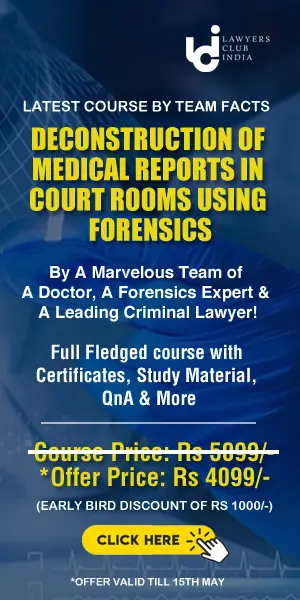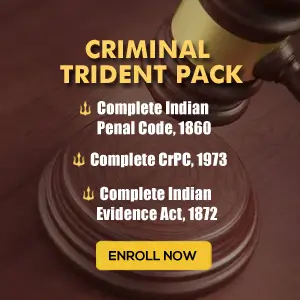KEY TAKEAWAYS
- Section 313 in the Criminal Procedure Code is crucial, providing the accused an opportunity to explain evidence against them, ensuring a fair trial.
- Judicial decisions, like Mehboob Batcha case, stress the indispensable nature of Section 313, debunking its perception as a procedural formality.
- Section 313 safeguards the accused's right to speak, aligns with natural justice, and shields them from perjury charges, ensuring a balanced trial process.
INTRODUCTION
Section 313 of the Criminal Procedure Code, 1973 gives the court the authority to ask the accused about the evidence presented against them. This aligns with the idea of natural justice, which means giving the accused a chance to speak and explain their side of the story, known as ‘Audi Alteram Partem.’This principle underlines the significance of the accused's right to be heard amidst the stages of a criminal trial —a cornerstone of fair and just legal proceedings.
The primary goal of introducing this section is to create a connection between the accused and the court. It is a moment when the accused, having listened to the case presented by the prosecution and the defence, is granted the opportunity to share their side of the story.
Section 313 CrPC introduces a unique interactive dimension to the trial. It empowers the judge to pose questions to the accused, seeking explanations or clarifications on any aspects of the case. This dialogue is not a mere formality; it serves as a vital bridge between the legal arguments presented and the personal narrative of the accused.
In situations where the accused cannot be present in court due to urgent reasons, they must apply and an affidavit. The document should explain why they cannot be there, assure no harm will come to them, and commit to accepting the court's final decision without questioning it.
According to the Code, the Trial Court must consider the entire case. Only information and facts made known to the accused can be used in the trial, not anything else. Clearly, the section aims to ensure the accused gets a fair trial by providing the right opportunities.
Judicial Interpretation of Section 313
The case of Mehboob Batcha v. State underscored the pivotal role of Section 313 in securing a fair trial. The Supreme Court emphasized the court's responsibility to diligently apply this provision, providing the accused with a meaningful opportunity to clarify incriminating circumstances. Stressing the need for precision, the judgment highlighted the court's duty to pose specific and relevant questions, allowing the accused to present a clear and comprehensive defence. Importantly, the ruling debunked any notion of Section 313 being a mere procedural formality, emphasizing its indispensable nature in upholding the principles of natural justice.
In the case of Janak Yadav v. State of Bihar [1999 9 SCC 125], the Hon'ble Supreme Court emphasized the importance of Section 313 CrPC as a procedural safeguard. The court acknowledged that this section provides a crucial opportunity for the accused to elucidate the facts and circumstances presented against them in the prosecution's evidence, underscoring its undeniable value.
In the case of Nar Singh v. State of Haryana [2015 1 SCC 496], the Supreme Court addressed the contrast in Section 313 CrPC. The court explained that there are two types of examinations under this section: one (Section 313(1)(a)) can happen at any stage, and it's optional, while the second (Section 313(1)(b)) occurs after prosecution witnesses testify but before the accused presents their defence, and it's mandatory. The court clarified that the first one is specific and a choice, but the second is general and compulsory.
The question should be clear, helping the accused understand what they need to explain and the circumstances requiring an explanation. Questions must be fair and presented in a way that even someone who is not well-educated can comprehend and respond to them.
An accused's option to stay silent according to Section 313(3) aligns with their right against self-incrimination under Article 20(3) of the Indian Constitution. Simultaneously, this provision shields the accused from facing perjury charges for providing false answers during their examination.
Nevertheless, in such situations, established legal principles dictate that the court "has the right to make conclusions, including drawing adverse inferences against the accused, as allowed by law." [Rajkumar v. State of M.P. [2014 5 SCC 353]
It is a well-established legal principle that not every accused must be examined under the mentioned section. If there is no evidence pointing to the accused, the court should not ask any questions. Answers given to improper or incorrect questions should not be considered. When the accused admits guilt or acknowledges the charges, there is no need for further examination. The legislative intent is not to seek an explanation from the accused when there is no evidence against them.
The statement made under Section 313 of the Code of Criminal Procedure is considered to understand the truthfulness of the prosecution's case, but it is not treated as evidence. This statement, taken without an oath, does not fall under the definition of evidence as per Section 3 of the Evidence Act. If the accused wishes, they can present other witnesses or testify themselves under Section 315 of the Code of Criminal Procedure to refute the charges. The statement under Section 313 is not considered evidence because the accused cannot be cross-examined based on those statements. However, if the accused chooses to testify in defence, their version can be examined through cross-examination.
Implications of Failing to Follow Section 313 Requirements
Not questioning the accused under Section 313 of the Cr.P.C does not automatically make the entire legal process or the prosecution's case invalid. The accused can address this issue even during the appeal. It is not the sole reason for dismissal unless the accused can prove a miscarriage of justice. In the State (Delhi Administration) v. Dharampal [AIR 2001 SC 2924] case, the court emphasized that the failure to bring certain incriminating details to the accused's attention does not necessarily ruin the proceedings. The accused must demonstrate that this omission led to a miscarriage of justice. In another case, Gyan Chand and Others v. State of Haryana [AIR 2013 SC 3395] , the court held that raising concerns about non-compliance with Section 313 for the first time at the Supreme Court level was not valid without showing how it harmed the accused. Simply having an imperfect examination under Section 313 is not enough to overturn a conviction unless it causes real harm to the accused.
Things need to be considered while examining the accused
- Section 313 of the Criminal Procedure Code (clause (b) of sub-section 1) is an important protection for the accused to prove their innocence during the trial process.
- Section 313 facilitates a direct conversation between the court and the accused, making it mandatory for the court to question the accused about the case, allowing them to personally explain any evidence against them.
- When questioned, the accused can choose to deny involvement altogether or admit to incriminating circumstances while using legally recognized defences.
- The accused, while making a statement under Section 313, is not subject to cross-examination by the prosecution, providing them the freedom to speak without fear.
-
- The explanations given by the accused, though not considered evidence under the Evidence Act, are relevant for determining the truth and examining the validity of the prosecution's case.
-
- The statements of the accused during Section 313 examination cannot be selectively used. They must be considered as a whole to understand the context and authenticity, especially regarding any self-incriminating or exculpatory admissions.
-
- If the accused presents a defence or offers an alternative version of events, the court must carefully analyse and consider these statements.
-
- Failure to consider the accused's explanation regarding incriminating circumstances could jeopardize the trial and impact the validity of a conviction in some cases.
CONCLUSION
In conclusion, Section 313 of the Criminal Procedure Code emerges as a cornerstone for ensuring a fair and just trial. It bridges the gap between legal arguments and the personal narrative of the accused, upholding the principles of natural justice. The judicial emphasis, particularly seen in cases like Mehboob Batcha, dispels any notion of this section as a mere formality, emphasizing its indispensable nature. By providing the accused with a meaningful opportunity to explain incriminating circumstances, Section 313 safeguards their right to be heard, promoting transparency in legal proceedings. However, careful consideration is crucial during the examination to avoid jeopardizing the trial. As the accused's statements, though not sworn evidence, are relevant, the court must weigh them thoughtfully. Overall, Section 313 stands not only as a procedural requirement but as a vital instrument in fostering fairness, dialogue, and justice within the criminal trial process.
Over time, Section 313 evolved from earlier legal provisions. Its inception reflects legislative intent to enhance the accused's participation in tria
Join LAWyersClubIndia's network for daily News Updates, Judgment Summaries, Articles, Forum Threads, Online Law Courses, and MUCH MORE!!"
Tags :Others

















